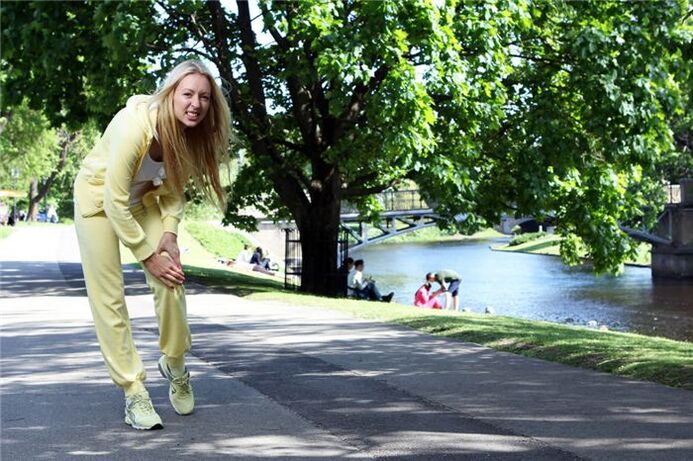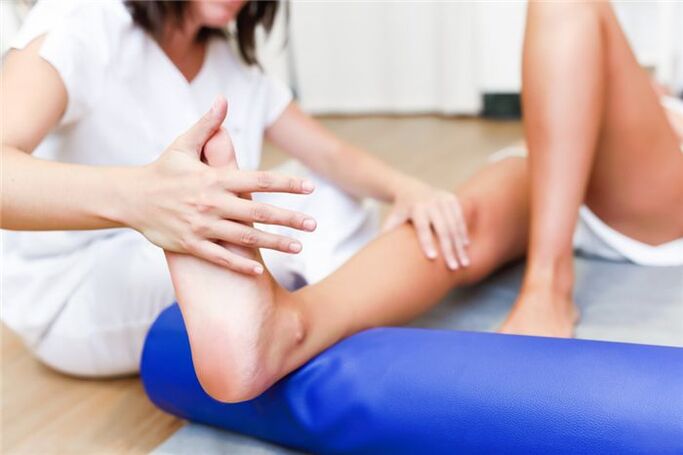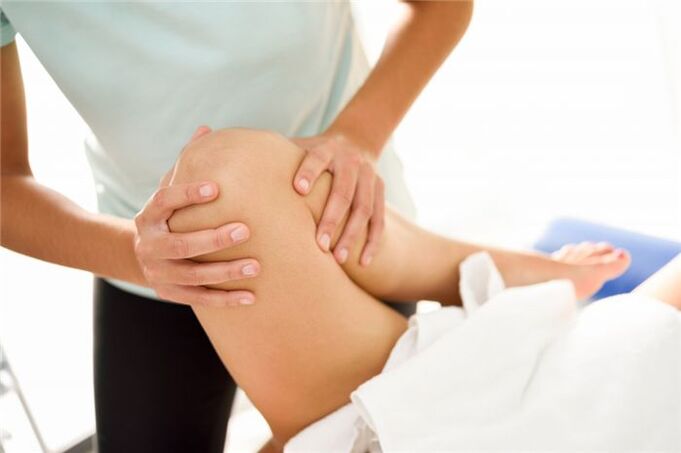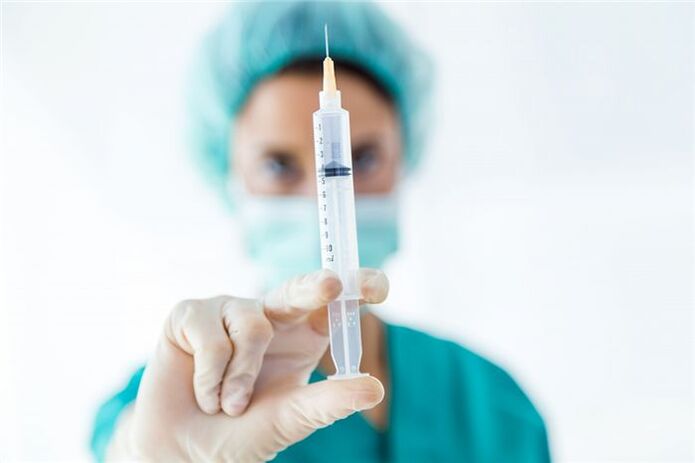Arthrosis of the knee jointis a degenerative-dystrophic disease of cartilage tissue, which leads to the exposure of the bone heads and impaired movement in the joints. The disease has a non-inflammatory nature and slowly develops - the transition from the initial stage to disability takes from several years to several decades. Knee osteoarthritis is one of the top 5 causes of disability and disability worldwide.
Osteoarthritis of the knee (gonarthrosis) affects more than 20% of people over the age of 55, but the disease is getting younger quickly - more often the symptoms appear at the age of 25.

Symptoms of knee osteoarthritis
Wear articular cartilage accompanied by characteristic signs, the intensity of which depends on the stage of the disease.Often, patients complain about:
- morning stiffness and reduced mobility in the joints (warming up is required upon waking);
- pain and discomfort in the knee, which increases after physical exertion (long walks, running or standing) and subsides with rest;
- on the 2nd stage - the so-called. starting pain that occurs after a long stay in one position;
- increased fatigue, which is often associated with age-related changes;
- dry rough dryness, which is often repeated when bending and bending the knees;
- edema and other inflammatory symptoms that appear in the 2nd stage of the disease due to trauma to the periarticular tissue;
- meteosensitivity, increased symptoms in winter.
When trying to bend the knee affected by gonarthrosis to a stop, there is a sharp pain and a feeling of physical obstruction. In the final stage, even with the treatment of arthrosis of the knee joint, the patient experiences a disturbed gait (becomes wobbly, the patient walks with stiff legs), defects in the lower part of the leg appear in the form of the letter "O" or "X". ".
The peculiarity of this disease lies in the fact that it can continue in a latent form for many years, and the first significant symptoms often appear only in the 2nd stage - when complete restoration of synovial cartilage is no longer possible.
Therefore, it is important to see a doctor at the first sign of discomfort in the knee - for example, weak, as if pulling pain that occurs when the production of synovial fluid is insufficient. Remember: knee pain is not normal, regardless of age. Timely examination and treatment of stage 1 knee arthrosis can protect you from severe joint pain in old age.
What happens if knee osteoarthritis is not treated?
With self-medication, non-compliance with the doctor's recommendations or no treatment, osteoarthritis of the knee joint develops on average 3-8 times faster than complex therapy. If gonarthrosis continues aggressively, the patient may lose the ability to move normally even before the onset of retirement age.
Especially important is the effective treatment of knee arthrosis in the acute stage. It can be provoked by cold damp weather, physical or emotional stress, allergies, poisoning, moving to an area with a different climate - in a word, any shock to the body. Exacerbation of arthrosis occurs with the destruction of a large number of chondrocytes. In response, the body produces enzymes designed to process and remove dead cells. However, if the concentration is too high, the healthy cartilage area also suffers - the cell membrane becomes thinner, foci of erosion appear on the synovial layer of the joint. This process, if not stopped by the treatment of knee arthrosis with drugs, can continue for several weeks, and with chronic stress, lack of sleep or insufficient diet, it can remain.
Finally, without treatment, osteoarthritis of the knee leads to a complete reduction in the lumen of the joint space due to the growth of osteophytes. The gap necessary for normal movement is closed, and the patient cannot bend the leg even by 30-45 °. The difficulty is not only climbing the stairs, but also trying to get up from the couch or normal movement. This condition is accompanied by pain, from which conventional analgesics do not help. In such cases, there is only one option for the treatment of arthrosis of the knee joint - surgery, with a complete replacement of the articular architecture with a prosthesis and subsequent long-term rehabilitation. But even in this case, most patients fail to return to a completely normal life.
Treatment of knee osteoarthritis
Depending on the stage of the disease and the condition of the joint, conservative or surgical treatment of knee joint arthrosis is used.
Treatment of knee joint arthrosis of the 1st degree is always carried out by conservative methods - with a combination of successful conditions and good self-discipline of the patient, it is possible to achieve a cure of the disease or a stable remission.
Treatment of arthrosis of the knee joint of the 2nd degree, as a rule, is based on the use of all conservative treatment methods, however, the doctor can decide on a minor surgical intervention on the joint if the disease develops aggressively or with complications.
Treatment for grade 3 knee osteoarthritis almost always involves surgery.
Comprehensive conservative treatment of arthrosis of the knee joint involves the removal of pain and inflammation, the restoration of cartilage tissue, and an increase in the range of motion in the joint. For this, the patient is prescribed an orthopedic regimen of load and rest, drugs of systemic and local action (hormonal and non-hormonal anti-inflammatories, analgesics, chondroprotectors and others). Innovative biological methods are also gaining popularity - injection of drugs for the treatment of arthrosis of the knee joint directly into the articular bag. In this case, PRP (platelet-rich plasma) injections are used, as well as stem cell injections obtained from the patient's own adipose tissue. In parallel, complementary and rehabilitation methods are connected - physiotherapy, massage, manual therapy, therapeutic exercises.
Surgical treatment of osteoarthritis of the knee joint is carried out in cases where drugs are ineffective.With this pathology, the doctor can prescribe the following interventions:
- Knee arthroscopy. A collective name for a group of minimally invasive operations aimed at removing a piece of broken articular tissue or osteophyte, or partial isolation of the articular membrane. It allows you to postpone or exclude prosthetics, as well as eliminate discomfort in the early stages of the disease. Used mainly for the treatment of knee arthrosis in patients under the age of 60.
- Osteotomy. An operation to cut part of the bone and correct the axis of load on the affected knee, which allows you to slow down degenerative changes. It is usually performed in the treatment of knee joint arthrosis of the 2nd degree.
- Endoprosthetics. Partial or complete replacement of the knee joint with a titanium implant, which lasts 15-20 years. This technique is a last resort because it carries certain risks. Recommended for patients over 55 years of age.
All these operations require a recovery period and have some contraindications, so the best option is prevention (exercise therapy, chondroprotectors) and treatment of knee arthrosis in the early stages.
In addition to the main treatment methods, diet therapy and other methods to reduce weight are used. To unload diseased joints, bandages and other orthoses (walking sticks, orthopedic insoles, etc. ) are used.
Treatment of knee arthrosis is prescribed by a rheumatologist or orthopedic specialist. At the first appointment, he palpates the joints, performs a motor test, and then directs the patient to tomography or radiography.
Therapeutic exercises for knee arthrosis
Therapeutic exercise for the lower limbs of the girdle is considered the most effective method to reduce pain and treat stage 1 knee arthrosis. The first results of therapeutic exercise come after 2-4 weeks of continuous exercise. Continuity in the treatment of arthrosis of the knee joint is one of the main factors affecting the effectiveness of exercise therapy. Full lessons are held 1 time a day every day, it is also recommended to do at least 3-4 exercises during the day.

The main task of physical exercise in the treatment of osteoarthritis of the knee joint is to strengthen the thigh and lower leg muscles, maintain the elasticity of ligaments and tendons, and combat muscle atrophy, which is a characteristic of arthrosis. This allows you to transfer the load from the joint to the periarticular structure - and thus slow down the mechanical wear of the cartilage, reducing inflammation.
Exercises for the treatment of knee arthrosis are performed for both legs! If there is a sharp pain, the session should be stopped or continued at a gentler pace.
- Starting position - lying on your back. One leg is extended on the floor, the other is raised bent at 90 ° (lower leg parallel to the floor). We perform movements with the lower leg up and down, as far as the range of motion in the joint allows.
- Starting position - lying on your back. Let's do bicycle exercise.
- Starting position - lying on your stomach. We swing our legs alternately, trying to bring the heel as close as possible to the back.
- Starting position - lying on your side, arms bent under the head or extended above the head in line with the body. The other hand is placed at the side. We swing up with straight legs. We change sides.
- Starting position - lying on your back. We pull the legs along the floor forward with the heels (away from you), the socks look "on themselves".
- Starting position - lying on your stomach. We do "boat" exercises. If physical fitness does not allow, we put our palms on both sides of the chest and take our legs back alternately, experiencing tension in the back of the thighs and the lower part of the legs.
- Starting position - lying on your back. We rotate the legs alternately, trying to describe a full circle with socks.
- Starting position - standing against the wall. We squat slowly and smoothly, without lifting our backs from the wall, to distribute the load. When the leg is bent at the knee by 90 °, we begin a smooth upward movement.
- Starting position - standing. Alternately we swing our legs forward, backward and sideways.
Please note: therapeutic exercises after surgery on the joint have their own specifics and vary depending on how many days have passed since the surgery. It is prescribed by a doctor - a surgeon or a rehabilitation specialist.
Massage for knee osteoarthritis
Therapeutic massage for knee arthrosis is performed on both legs. At first, at least 10-12 sessions are usually required with a masseur-rehabilitologist or with the help of hydromassage equipment, however, simple rehabilitation massages can be done at home. It includes the following types of movement:
- superficial stroking and rubbing (up and down, clockwise and counterclockwise);
- probing and stretching with the fingertips the deeper tissues;
- pinching and tapping on the skin.

Self-massage can be combined with the treatment of arthrosis of the knee joint with drugs: it will not be superfluous to use warming ointments or balms before or during the session. You can also take a warm shower before the procedure.
Important: massage is contraindicated in patients with inflammatory symptoms (osteoarthritis or exacerbation of arthrosis). In this case, acute phase therapy is required.
Diet therapy for arthritis
The standard nutritional protocol for treating osteoarthritis of the knee requires:
- limit foods and dishes rich in simple carbohydrates (white bread, pastries, snacks, sweets, potatoes, sugar);
- excluding processed (ready-to-eat) and salt-rich dishes - fast food, semi-finished products, sausages;
- avoid alcohol, decaffeinated coffee and fatty meats.
Instead, enter in the menu:
- dishes from sprouted grains and whole grains;
- fatty fish in the north sea and diet chicken meat;
- cartilage (ears, nyushki, legs and other parts of farm animals rich in collagen), aspic and jelly;
- fruits and vegetables rich in vitamins and antioxidants (especially vitamins A, B12, C, E);
- nuts and other sources of omega fatty acids and valuable minerals.

It is also recommended to treat osteoarthritis of the knee joint with drugs - vitamin-mineral complexes (2 courses per year).
Physiotherapy for the treatment of knee osteoarthritis
The following physiotherapy procedures are used to effectively treat knee arthrosis and enhance the effect of medications:
- magnetotherapy;
- laser therapy;
- UHF;
- ultrasound therapy;
- amplipulse;
- electrophoresis (including drugs - with analgin, novocaine or chymotrypsin);
- application of ozokerite and paraffin;
- thermotherapy (cryotherapy, inductothermy);
- phonophoresis (in particular, with hydrocortisone);
- balneological therapy (sulfur, hydrogen sulfide baths).
Acupuncture in the treatment of knee joint arthrosis of the 2nd degree, as a rule, is not used.
Before visiting the procedure, it is necessary to consult your doctor - many types of physiotherapy are contraindicated in case of exacerbation of the disease.
Medicines for the treatment of arthrosis of the knee joint
Treatment of osteoarthritis of the knee joint with drugs is carried out symptomatically and takes into account the patient's individual response to the selected drugs. Drug therapy - injections, ointments or tablets for the treatment of knee arthrosis - is usually prescribed in a course or as needed.

There are several directions in the treatment of arthrosis of the knee joint with drugs: making life easier for the patient, improving cartilage nutrition, regenerating cartilage tissue, and maintaining a normal musculoskeletal system.
Nonsteroidal anti-inflammatory drugs
To relieve exacerbations, NSAIDs in tablets or capsules are taken in a course (about 12 days) or as needed, depending on the intensity of the pain syndrome. Uncontrolled intake of NSAIDs that violates the doctor's instructions or recommendations is fraught with stomach or intestinal ulcers. They should be taken very carefully in combination with glucocorticosteroids and drugs that affect blood clotting. Additional risk factors are age over 65 years, smoking, drinking alcohol during the course. In this case, doctors usually recommend drug injections, bypassing the gastrointestinal tract. Together with NSAIDs, it is desirable to take gastroprotectors.
The maximum effect can be achieved with a combination of systemic NSAIDs (for internal use) and external - in the form of ointments, creams or gels. The second option provides a spot effect on the affected joint and at the same time minimally affects digestion.
Corticosteroids (steroid drugs used to treat osteoarthritis of the knee)
Hormonal drugs (HA) are usually used for the so-called. steroid blockade of the knee in cases where NSAIDs are insufficient to relieve pain and inflammation.
Glucocorticoid injections are considered the last resort in the treatment of knee osteoarthritis with drugs. They provide relief as early as 20 minutes after administration, but can cause hormonal imbalance and cartilage damage if taken incorrectly. Due to side effects, many orthopedists prefer knee surgery to long-term HA therapy.
Chondroprotectors in the treatment of arthrosis of the knee joint
Chondroprotective agents based on extracts from veins and cartilage of cattle, sea fish and shellfish contribute to the restoration of synovial cartilage, and are therefore indispensable for the effective treatment of knee arthrosis. Chondroprotectors contain a large amount of glycosaminoglycans - natural polymers from which cartilage tissue is built. Therefore, they make chondrocytes (cartilage cells) more stable, promote their growth, enrich the synovial fluid.
Unlike anti-inflammatory drugs, chondroprotectors have almost no contraindications. They provide a cumulative, long-lasting effect - the first improvement occurs after 1-3 months of admission, and the duration of the course is 3-6 months.
Irritating to the skin
External preparation for the treatment of knee arthrosis with a local irritating effect improves blood circulation and joint nutrition, and also distracts the patient from pain. For this purpose, ointments, gels, creams and balms are used based on natural ingredients - bee venom, hot pepper extract.
In the presence of allergic reactions (persistent redness and skin pain, rashes), during pregnancy and breastfeeding, as well as in the presence of other contraindications, it is better to avoid warming ointments for the treatment of arthrosis of the knee joint and limit yourself to warm baths, rubs and anti-inflammatoryexternal
Synovial fluid prosthesis
If there is too little synovial fluid in the joint, the gliding of the articular surface is disturbed. And most importantly, cartilage starvation begins, because the joint fluid that nourishes it like a sponge usually provides nutrients for the growth and maintenance of cartilage tissue. To prevent cellular destruction and mechanical abrasion of the knee cartilage, the doctor may prescribe injections of high molecular weight hyaluron derivatives. Drug injection in the treatment of arthrosis of the knee joint (viscosupplementation) is made directly into the joint capsule, which leads to rapid relief, which lasts from 3 to 12 months after completing the course. However, with the introduction of a prosthesis, the risk of necrotic changes or infection in the joint remains.
Antispasmodic, analgesic, muscle relaxant
In cases where muscle spasms and tension prevent the patient from falling asleep, creating pain during movement, the doctor prescribes antispasmodics and muscle relaxants.
Simple analgesics are not used in the treatment of arthrosis of the knee joint, because they mask the pain, but do not relieve inflammation. You can use it or NSAIDs available without a doctor's prescription for up to 10 days, after which an examination is required.
Release form of the drug for the treatment of arthrosis of the knee joint
For the convenience of patients, drugs for the treatment of arthrosis of the knee joint are produced in various forms. Is there a difference between them and which one should I choose?

Capsules, sachets and tablets for the treatment of knee arthrosis
Non-steroidal anti-inflammatory drugs, corticosteroids, chondroprotectors and muscle relaxants are available in oral form. In this case, they are easy to dose, reception is possible without the participation of medical workers, it is easy to control which part of the course has been completed. When taken orally, chondroprotectors and NSAIDs have relatively high bioavailability (especially in the form of sachets).
Solution for injection
In the form of injections, you can take the already mentioned NSAIDs, HA, chondroprotectors and muscle relaxants, as well as synovial fluid prostheses. Methods of treating osteoarthritis of the knee joint with drugs showing maximum bioavailability.
The method of treating knee arthrosis with this drug is safe for digestion, but it is desirable that the injection (intravenous, intramuscular to the joint area or intra-articular) is given by qualified medical personnel. Intramuscular injections in the buttocks or thighs can be done independently.
Products for external use
Irritant, anti-inflammatory and chondroprotective local ointment is used externally for the treatment of arthrosis of the knee joint. The advantage of the administration of this drug is the direct effect on the affected tissue. But the skin barrier prevents the active substance - unfortunately, often only 5% of the active substance reaches the desired tissue layer.

























